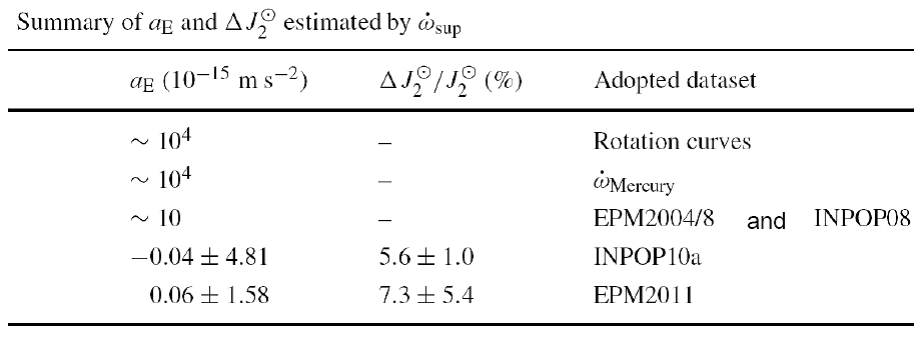With tremendous advance in the accuracy of observations, Einstein’s general relativity (GR) has passed nearly all the tests in the solar system. However, alternative gravity theories still stand up for explaining some exotic phenomena such as the dark matter and for possible violation of GR in the future higher precision experiments. As a generalization of GR, the f(R, T) gravity replace the gravitational Lagrangian of GR with an arbitrary function of the Ricci scalar R and of the trace of the stress-energy tensor T. It can induce an extra acceleration a E in the dynamics of massive test particles due to the physical coupling between matter and geometry.
In the current work, by using the supplementary advances in the perihelia provided by current INPOP10a and EPM2011 ephemerides, the authors find that INPOP10a yields the upper limit as a E=(-0.04±4.81)×10-15m s-2 and EPM2011 gives a E=(0.06±1.58)×10- 15m s-2 (see the table). Both of them are improved at least by about 10 times than previous results obtained in the solar system and they are smaller than the results given by fitting rotation curves of galaxies by about 4 orders of magnitude. This discrepancy of a E on these scales seems to imply that its effects might be screened in high density regions.

This work is done by Dr. Xue-Mei Deng of Purple Mountain Observatory who is collaborated with Dr. Yi Xie of Department of Astronomy in Nanjing University. And this research is supported by the National Nature Science Foundation of China and the National basic research program of China (Nos. 11473072, 1103085 and 11103010) and the Fundamental Research Program of Jiangsu Province of China (Nos. BK20131461 and BK2011553). For more details, please see the following link: http://link.springer.com/article/10.1007%2Fs10773-014-2377-1
